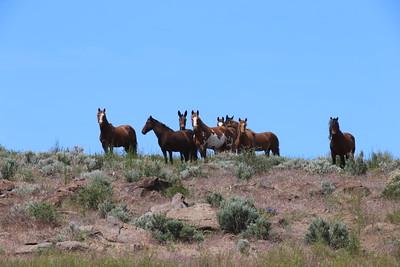BLM to gather wild horses, burros, from Twin Peaks Herd Management Area
Organization:
BLM Office:
Media Contact:
SUSANVILLE, Calif. – The Bureau of Land Management on Saturday, July 23, will begin gathering excess wild horses and burros from public lands to maintain herd and habitat viability in the Twin Peaks Herd Management Area, along the California-Nevada border in Lassen County, Calif. and Washoe County, Nev.
The BLM plans to capture approximately 2,000 wild horses and remove approximately1,800 from the range. The plan calls for capturing and removing 339 wild burros. The BLM plans to treat 110 mares with a fertility control vaccine and release them back onto the range.
“Our goal is to establish and maintain healthy wild horses on healthy lands in balance with other authorized range users,” said Emily Ryan, manager of the BLM Eagle Lake Field Office in Susanville. “The wild horse and burro populations in the herd management area have grown well beyond the population range established in our land use plan. The Wild Free-Roaming Horses and Burros Act requires that the BLM remove from the range animals in excess of appropriate management levels and as habitat conditions dictate.”
The BLM will establish public viewing areas at all capture sites and allow public observation daily. Those who wish to view operations should reserve a spot by calling an information line at 530-252-5332. The information line will be updated every evening with information for the meeting location and time for the following morning. Some viewing sites may accommodate limited numbers.
Those wishing to observe the public viewing must provide their own transportation. The BLM highly recommends viewers arrive in a high clearance four-wheel-drive vehicle with sound tires, a good spare tire, and tire changing equipment. Visitors should be prepared for a full day in hot conditions, bringing plenty of water and food. The BLM recommends a folding chair, sunscreen, a wide-brimmed hat and sunglasses. Brightly colored clothing and shade structures are not permitted. There is no shade or restroom facilities at the viewing sites. Most sites will have no cell service.
An environmental assessment (EA) analyzing impacts of the population management actions was released for public review and comment earlier this year. Comments were addressed and incorporated into the final plan where appropriate. The EA is available at https://eplanning.blm.gov/public_projects/nepa/122967/20007646/250008780/Final_Environmental_Assessment_508.pdf.
The BLM will conduct gather operations using the drive trap method. Captured horses will be transferred to the Litchfield Wild Horse and Burro Corrals near Susanville, CA; the Palomino Valley National Wild Horse and Burro Center near Reno, NV; and BLM Corrals near Bruneau, Idaho.
The Twin Peaks HMA covers nearly 800,000 acres, mostly public lands managed by the BLM. An aerial census and statistical verification conducted this spring shows there are approximately 3,300 wild horses and 400 wild burros in the HMA. The appropriate management level – the number of wild horses and burros the land can sustain in balance with other users – is a range of 448 to 758 wild horses and 72 to 116 wild burros.
Wild horses and burros are protected on BLM-managed lands by the Wild Free-Roaming Horses and Burros Act, a federal law. The law requires the BLM to determine population levels that allow wild herds to thrive in balance with other range users including wildlife and livestock and to remove animals in excess of that population.
Horses and burros removed from the range are made available for private care through adoption or sale. Horses not adopted or purchased by members of the public are placed in leased Midwest pastures where they retain their protected status.
The BLM manages about 245 million acres of public land located primarily in 12 western states, including Alaska, on behalf of the American people. The BLM also administers 700 million acres of sub-surface mineral estate throughout the nation. Our mission is to sustain the health, diversity, and productivity of America’s public lands for the use and enjoyment of present and future generations.

